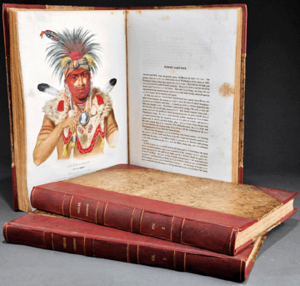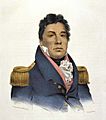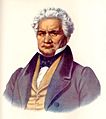History of the Indian Tribes of North America facts for kids
 |
|
| Author | Thomas L. McKenney, James Hall |
|---|---|
| Illustrator | Three frontispieces after Peter Rindisbacher and Karl Bodmer, and 117 portrait plates after Henry Inman's copies of the original oil paintings, mostly by Charles Bird King, and drawn on stone by Albert Newsam, Alfred Hoffy, Ralph Tremblay, Henry Dacre, and others, printed and colored by J. T. Bowen and others |
| Country | United States |
| Language | English |
| Subject | United States History, Native Americans |
| Published | First edition of v. 1 published by E.C. Biddle, Philadelphia, 1836.; Volumes 2-3 published by D. Rice and J.G. Clark, 1842-44. |
|
Publication date
|
1836-1844; 1872 |
| Media type | Hardcover |
| OCLC | 3331971 |
The History of the Indian Tribes of North America is a special three-book series. It tells the life stories of many Native American leaders. Each story comes with a picture, called a lithograph, which is like an old-fashioned print.
These books were first published in the United States between 1836 and 1844. They were created by Thomas McKenney and James Hall. Most of the pictures were originally oil paintings by an artist named Charles Bird King.
Thomas McKenney worked for the US government. He was in charge of trade with Native American tribes. Later, he led the Office of Indian Affairs, which was part of the War Department. He wanted to create these books to save a record of important Native American leaders. He believed their way of life was changing quickly.
McKenney asked Charles Bird King to paint portraits of leaders. These leaders often visited Washington, D.C., to discuss treaties. He also asked James Hall to write their biographies. The goal was to share these important stories and images with everyone.
Creating the Portraits
Starting around 1821, Thomas McKenney began a special project. He was the US Superintendent of Indian Trade. He asked artist Charles Bird King to paint portraits of Native American delegates. These delegates came to Washington, D.C. to talk with the government.
McKenney continued this project when he became head of the Office of Indian Affairs. King painted many portraits until 1837. Other artists also helped, like James Otto Lewis, Peter Rindisbacher, and Henry Inman.
McKenney wanted to save these images for the future. He felt it was important to remember these leaders. He believed Native American cultures were facing big changes. He wanted people to see them as "human beings, having bodies and souls like ours."
At first, the paintings were kept in the War Department building. This department handled Native American affairs back then. In 1858, the original paintings moved to The Castle. This was the first building of the Smithsonian Institution. It was used to store and show artworks.
Publishing the Books
To share these portraits widely, McKenney decided to make prints. These prints were called lithographs. Each portrait would have a full biography written about the person. The plan was to publish three large books.
McKenney hired James Hall to write the biographies. Hall was a judge and a well-known writer. However, Hall found it hard to write the stories. McKenney had promised to give him information, but he didn't. Hall spent eight years researching the people. McKenney had given him little more than their names.
The books were expensive to make. The full set cost $120, which was a lot of money back then. A financial crisis called the Panic of 1837 hit the country. Many people who had promised to buy the books couldn't afford them anymore. Because of this, McKenney left the project.
James Hall and a new publisher finished the series. The last part came out in January 1844. Even with all the problems, 1,250 people eventually bought the full set.
The Smithsonian Fire of 1865
In the winter of 1865, a terrible fire happened at the Smithsonian. Workers were moving the portraits. They brought in a wood-burning stove to keep warm. They put the stovepipe into a shaft, thinking it was a chimney.
After two weeks, a big fire started in that shaft. The second floor of The Castle building caught fire. Then, the roof collapsed. It was the worst fire in the Smithsonian's history.
Sadly, 295 of the original Native American portraits were destroyed. Only five were saved. One artist had made a few copies of his favorite paintings. But almost all the original portraits would have been lost forever. Luckily, McKenney, Hall, and their team had already made the lithographs and published the books. These books are now a very important record of Native American leaders from the early 1800s.
Gallery
-
Amiskquew, A Menominee warrior
-
A-na-cam-e-gish-ca, A Chippeway (Ojibwe) chief
-
Jack-O-Pa, An Ojibwe chief
-
Kee-shes-wa, A Fox chief
-
Little Crow, A Sioux chief
-
Choctaw chief Pushmataha, 1824
-
Red Jacket, Seneca orator and chief of the Wolf clan
-
Cherokee Major Ridge, 1834
-
Sequoyah or George Guess, creator of the Cherokee alphabet
-
Tah-Chee (Dutch), A Cherokee chief
















